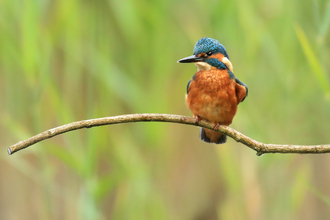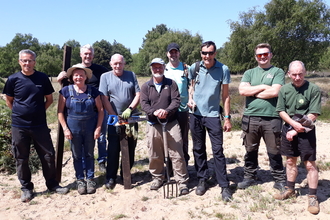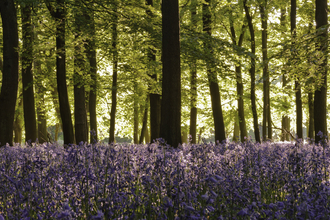What is the Kingfisher Trail?
The Kingfisher Trail is a scenic 14-mile route connecting the rural West Pennine Moors to the urban centres of Bolton, Bury and Salford.
Brimming with biodiversity, the Kingfisher Trail is a 20-year labour of love that connects people to sites including Seven Acres Local Nature Reserve, Leverhulme Park Local Nature Reserve and Nob End SSSI.
Working with community groups and dedicated organisations, we have, and continue to, revive sites along the Trail and encourage the public to explore this stunning area on foot or even two wheels. This project is all about sharing, whether knowledge, resources or expertise, to better manage the route and improve it for both people and nature.
We want the Kingfisher Trail to be one of the most important areas in Greater Manchester for people to engage with nature, learn about their local heritage and have fun with their families, friends and communities.
Our vision for the Kingfisher Trail
By improving, promoting, celebrating and engaging people with the Kingfisher Trail, we want to create a nationally important network of wild sites that embrace their industrial past and connect both rural and urban communities to the biodiversity and heritage of the local area. Our partners and volunteers are integral to helping us:
- Explore new ways to interpret and communicate the heritage, biodiversity and community value of the Kingfisher trail.
- Prioritise practical habitat conservation and access improvements.
- Plan exciting community engagement activities and events designed to enthuse visitors to the Trail.
Where can you explore?
Upper Bradshaw Valley Local Nature Reserve
Textiles were worked on here from 1542, but gently nodding bluebells and twittering birds have replaced the once billowing chimneys of Bradshaw Works. Though the remains of this industry can be seen in the Leat or Mill Race, the reserve is now home to a thriving wildlife population which is testament to the way in which nature can reclaim the land.
Access: Jumbles Country Park Car Park, off Bradshaw Road, Bolton.
Accessible: Not suitable for those with limited mobility.
Longsight Park
Historic houses, great geology, terrific trees; this stunning sight has something for everyone. Marvel at the beauty of the arboretum and appreciate the rocky outcrop alongside the river – a reminder of the days when the valley was quarried for coal. Keep your eyes peeled for fossils.
Access: Longsight Park Arboretum Car Park, off Bradshaw Brow, Bolton.
Accessible: Not suitable for those with limited mobility.

Wood anemone by Mark Hamblin/2020VISION
Firwood Fold
This beautiful little hamlet is most famous as the birthplace of the inventor Samuel Crompton, but don't miss the pretty plantlife. The large reservoir behind Samuel Crompton's house brims with bittersweet, enchanter's nightshade, wood avens, lesser celandine and wood anemone.
Access: Firwood Lane, Bolton, BL2 3AG.
Accessible: Firwood Fold itself is on a gradual slope but is cobbled. The bunk and lodges are not suitable for those with limited mobility.

Brian Hogan
Seven Acres Local Nature Reserve
This 68 acre site reflects the importance of water to past industry, when the area was covered by lodges, ponds and brooks that added up to exactly ‘seven acres’. Now, wildflower meadows, heathland, woodland and wetland habitats support a whole host of wildlife including the key indicator species, the dipper.
Access: Seven Acres LNR Car Park, off Thicketford Road, Bolton.
Accessible: Riverside paths accessible with radar key.

Peter Hunter
Leverhulme Park Local Nature Reserve
The convergence of Bradshaw Brook and the River Tonge is a true ‘living landscape’. This green corridor supports an exciting array of birdlife, including herons and the iconic jewel of our rivers, the kingfisher. Don’t forget to look up at the towering beech trees; you might be lucky enough to spot a great-spotted woodpecker or tawny owl.
Access: Leverhulme Park Car Park, off Long Lane, Bolton.
Accessible: Riverside paths accessible although with steep gradient.

Alan Bromiley
Darcy Lever Gravel Pits
This historic part of the Kingfisher Trail follows the old canal towpath which once carried coal mined at Fogg’s Pit. Hidden within the woodland, this tranquil oasis is home to all five of our inland amphibians: common frog, common toad, smooth newt, palmate newt and great-crested newt. You’ll also find one of the best dragonfly populations in the North West. Click here for more information about this site.
Access: Via Radcliffe Road at the northern end, or Hall Lane at the southern.
Accessible: Not suitable for those with limited mobility.

Mike Jowles
Moses Gate Country Park
Bolton’s largest nature reserve is 750 acres of pure peace and tranquillity. Mill lodges and clues to local heritage hark back to the sites former life as one of the biggest paper producers in the country. Now, the remaining pools support a range of waterfowl including common terns and mute swans, while the woodland is the perfect place for a quiet stroll.
Access: Moses Gate Country Park Car Park, off Hall Lane, Bolton.
Accessible: Pathways around lodges accessible for all.

Nob End Site of Special Scientific Interest (SSSI)
The jewel in the crown of the Kingfisher Trail harbours rare orchids and offers stunning views of the Croal and Irwell rivers. This former dumping ground for sulphuric acid and washing soda has weathered into an alkaline-rich haven that supports bee orchids, marsh helleborine, autumn-gentian and other unusual plants in a rare collection unique to Manchester.
Access: From Boscow Road, via Prestolee Road, Little Lever, Bolton.
Accessible: Not suitable for those with limited mobility.

James Hall
Manchester, Bolton and Bury Canal
Opening the valley up to industry in 1797, the Manchester, Bolton and Bury Canal left a lasting legacy when it closed to traffic in 1961. Now, nature has given the waterway a new lease of life; several long ponds providing prime habitat for amphibians, dragonflies, fish and water birds. Keep your eyes peeled for kingfishers and don’t miss the Meccano Bridge, assembled entirely on-site using giant Meccano pieces.
Access: From Boscow Road, via Prestolee Road, Little Lever, Bolton.
Accessible: Not suitable for those with limited mobility.

Mark Hamblin/2020VISION
Ringley Woods
Much of Ringley Woods is classed as ancient and is home to all the wildlife you would expect to find in an ancient woodland. Keep your eyes peeled for treecreepers and nuthatches, and listen out for the calls of buzzards, sparrowhawks and tawny owls among the towering clusters of sycamore, willow and English oak trees. Ringley Woods really shine in spring, when they are resplendent with bluebells and wild garlic.
Access: From behind Horseshoe Pub, Ringley, M26 1FT.
Accessible: Ringley Bridge, stocks and Saint Saviours all accessible. Kingfisher Trail path not suitable for those with limited mobility.

Andrew Parkinson/2020VISION
Clifton Country Park
One of Salford’s best green spaces; a wonderful place to immerse yourself in wildlife, geology and industrial history. The large lake – created when gravel was extracted for the construction of the nearby motorway – is a haven for water birds and a great place to watch the delightful springtime dance of the great-crested grebe. Clifton Country Park was also a favourite haunt of L.S. Lowry, providing access to the wider valley that he immortalised throughout his life.
Access: From Clifton House Road, Clifton, M27 6NG.
Accessible: Path around the lake accessible for all.
Waterdale and Drinkwater Park
Though now disused, the monolithic 13-arch railway viaduct that dominates this part of the Kingfisher Trail is a reminder of the area's former life as a thriving industrial hub. Now, kingfishers hunt at Damshead Lodge, while kestrels, sparrowhawks, buzzards and even peregrine falcons can be seen along the impressive viaduct.
Access: Park Lane, Whitefield, M45 7QJ, or at the bottom of Buckley Lane, Prestwich, M45 7JZ.
Accessible: Reaching the site from Philips Park involves a long descent into the steep-sided valley. Access from Buckley Lane is along mostly flat, excellent quality paths.

Mark Hamblin/2020VISION
Philips Park Local Nature Reserve
Remnants of industry stand proud against a backdrop of wildflower meadows and plantation woodland where kestrels hover, buzzards circle and woodpeckers drum. Formal gardens are the last reminder of the large house and estate that once belonged to the Philips family. The park is also a haven for cyclists who can enjoy a purpose-built mountain bike trail and connection to National Cycle Route 6.
Access: Park Lane, Whitefield, M45 7QJ.
Accessible: Not suitable for those with limited mobility.
Download the Kingfisher Trail guide
Want to plan your fascinating trip along the Kingfisher Trail? Download the full information guide below to find out more about each site, and plot your journey using the map.
Download the Kingfisher Trail guide






